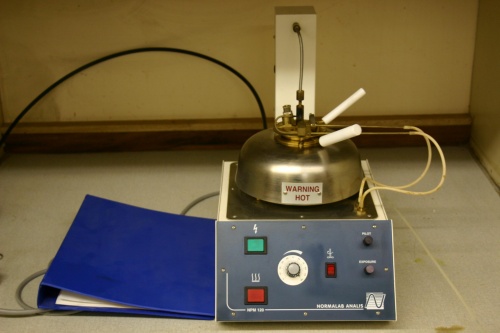From Chemical Engineering @ UP wiki
|
|
| Line 1: |
Line 1: |
| − | [[File:Mettler_%282010%29.JPG|500px|right|thumb|The Mettler Mass Comparator in the Tribology Lab]] | + | [[File:Pensky_Martin.JPG|500px|right|thumb|The Pensky Martin Closed Cup Tester in the Tribology Lab used to determine the flash point of petroleum products and lubricants.]] |
| − | The Mettler Coparator Balance is not a normal mass meter. It is used for measuring very small changes in mass AND SHOULD ONLY BE USED TO MEASURE THE FZG GEARS BEFORE AND AFTER TESTS.
| + | |
| | | | |
| | == Documentation == | | == Documentation == |
| − | Mettler Mass Comparator User Manual is available [ftp://anonymous@ragnarok.up.ac.za/publicftp/lab/Tribology/Mettler%20Mass%20Comparator/User%20Manual%20%28Mettler%29.pdf here]. Please read the manual before using the instrument.
| |
| | | | |
| − | == Time Line == | + | == Test Procedure == |
| − | Comparator fixed by Mettler and returned on 27 June 2010.
| + | |
| − | | + | |
| − | == User Tips ==
| + | |
| − | When starting the instrument in the morning, place a weight of known mass onto the scale and take the reading. Write the value down. If this value deviates too much from the original value (the value on the day of calibration), contact the Mettler people to re-calibrate the machine. The following weights were measured on 04 June 2010:
| + | |
| − | * Gerrie's 2 kg weight = 1999.820 g
| + | |
| − | * Gerrie's 1 kg weight = 1000.141 g
| + | |
| − | | + | |
| − | Another useful tip is to move the weight around on the surface of the scale when you make your first reading. This ensures that the whole surface is "activated" and ensures better accuracy.
| + | |
Revision as of 13:46, 9 July 2010

The Pensky Martin Closed Cup Tester in the Tribology Lab used to determine the flash point of petroleum products and lubricants.
Documentation
Test Procedure
